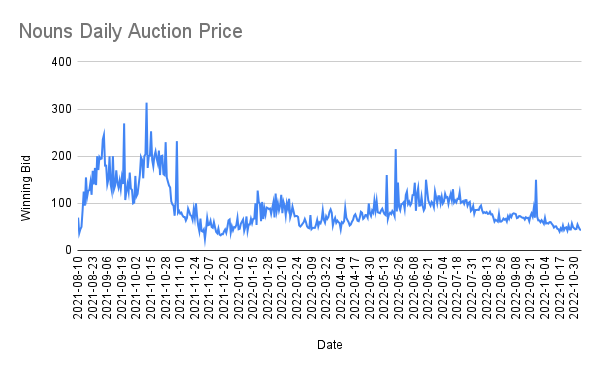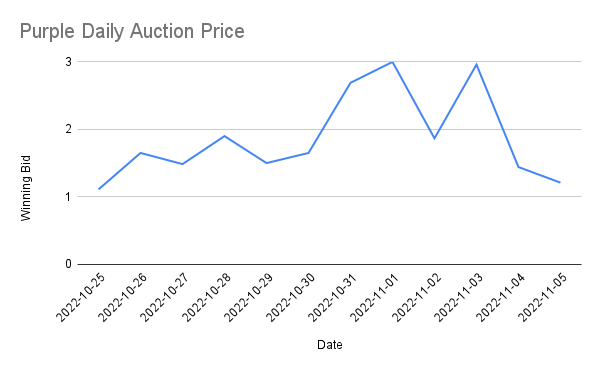Why I joined Purple

Purple is an on-chain organization whose goal is to proliferate and expand the Farcaster protocol and ecosystem.
Its governance is influenced by Nouns; the treasury is funded by daily auctions of one NFT, everyday, forever. At the time of writing, 15 Purple token holders control a treasury of ~21 ETH.

I joined Purple by purchasing Purple #15 in a daily auction. This post explains a bit about Purple, why I'm excited about it, and what I hope to see it achieve. All opinions are my own and don't represent those of the organization or other members.
What is Purple?
There aren't many examples of institutions like Purple, so I'll start by describing what it's not:
- Purple is not officially associated with Merkle Manufactory, the company behind Farcaster.
- Purple is not a startup or a non-profit.
- Purple is not private – anyone can join by buying a Purple DAO NFT.
Purple is an on-chain mechanism to fund projects that benefit Farcaster.
Ecosystem development for new protocols suffers from the cold start problem: builders are not incentivized to create products for new protocols until there are users, and users are not willing to try new protocols until there are sufficiently good products.
Purple is an attempt to fill this gap by providing capital through grants and funding requests to builders and creators who are improving the Farcaster ecosystem.
How Purple Makes Money
Purple makes money by selling a governance token that represents a voting stake in deciding how the treasury is deployed. In return for their investment, token holders receive social status and influence over the shared treasury.
The price of the governance NFT is determined by the market through a daily auction. Anyone can place a bid to purchase a Purple NFT. The highest bidder at the end of the 24 hour period receives the Purple NFT and the other bidders are refunded.
The value of the governance token is influenced by the net asset value of the treasury, as well as the ability of the token holders to coordinate in deploying capital from the treasury. The most successful project of this type, the Nouns DAO, has an average price of 92 ETH across >450 Noun sales.

Purple has an average price of 1.8 ETH across 12 Purple sales.

How Purple Makes Decisions
The organization makes decisions on-chain through a series of smart contracts which are controlled by Purple token holders.

Token
Purple ($PRPL) is an ERC-721 token. The issuance of the token is determined by the daily auction schedule, as well as the % of tokens issued to Founders and special groups like the Nouns DAO and the Merkle multisig.
Metadata Renderer
The Metadata Render is a smart contract that generates a random number used to select a unique image for the daily auction. This is less relevant for Purple, as the default image for new NFTs is a simple purple square.
Auction
The Auction is an automated smart contract that accepts bids and settles the current auction by delivering the daily NFT to the highest bidder. The auction lasts 24 hours and restarts when the previous auction has been settled. Anyone can trigger the settlement of an auction.
Treasury
The Treasury contains all funds from the daily auctions. Purple's Treasury is 100% controlled by token holders. No one else can move funds from the Treasury, including the Farcaster team or the founder multisig.
Governor
The Governor is a smart contract that can trigger the release of funds from the Treasury if a proposal has received a majority For vote and passed the Quorum Threshold.
Where Purple Can Help
Purple can help by funding Farcaster ecosystem projects that don't have a clear path to a for-profit business model.
This includes public goods which require ongoing or one-time funding, as well as retroactive funding for projects which provided value to the Farcaster ecosystem without an expectation of financial gain.
Why not fund for-profit projects? Because there are already established ways for startups to raise money from investors in exchange for equity or tokens. On the margin, Purple can provide more utility by encouraging projects that wouldn't otherwise happen. Projects that can be for-profit should be. For those that can't, there's Purple.
At least two types of funding models are well suited to the Purple governance model:
- Prop House: useful for allocating a fixed amount of capital to multiple parties. Prop Houses can be launched on a recurring schedule (e.g. once per month) and community members can apply to receive a grant from the funding round. Prop Houses can also be focused on specific topics based on perceived gaps in the ecosystem.
- Proposals: useful for lump sum funding to bring a specific idea to life. Proposals can be raised by Purple members and must meet the proposal threshold to be taken to a vote.
Why I'm Excited About Purple
I'm excited to help build an Internet-native institution that is focused on funding public goods.
Many of the public goods that power the internet today, like open-source software, rely on the goodwill of for-profit corporations to keep them running via donations or internal programs. Purple is a way to fund public goods without relying on one-off acts of charity.
I hope that the existence of Purple (and other DAOs like it) encourage builders to work on projects that otherwise wouldn't happen.
Although Purple is a series of smart contracts, it's also a social technology. The ability to set a Purple NFT as your default avatar in the Farcaster client gives holders a way to signal that they have skin-in-the-game. In turn, this can nudge users toward NFTs that contribute to valuable social causes.
How To Join
The Purple daily auction is the best way to join and help fund the treasury. To learn more about Purple membership and current funding proposals, join our Discord.
See you on the Far Side.
